A dice-rolling worker placement game where players compete to be Tidal Blades: elite guardians of the island realm
60-90 minutes
Designer: Tim Eisner, Ben Eisner
Artist: Lina Cossette, David Forest
Publisher: Druid City Games
Tidal Blades: Heroes of the Reef is another in a recent trend of games that fits role playing game (RPG) concepts into board game mechanisms, marrying the best of both worlds to reach a wide audience.
We hold to the idea that there’s a time and a place where we like certain types of games. Sometimes we want our brains to melt with games like On Mars. Sometimes we want something lighthearted at the end of a long day. And sometimes we want to just have a good time. Tidal Blades is definitely in that final category. What it lacks in weight (for us) it more than makes up with that tough to capture “fun factor”.
Here, we’ll review Tidal Blades and the Angler’s Cove expansion as well as give an overview of the game and how it fits into our busy lives.
Tidal Blades was generously given to us by the publisher. As always, we strive to be fair and objective. For more information, see our Review Policy.
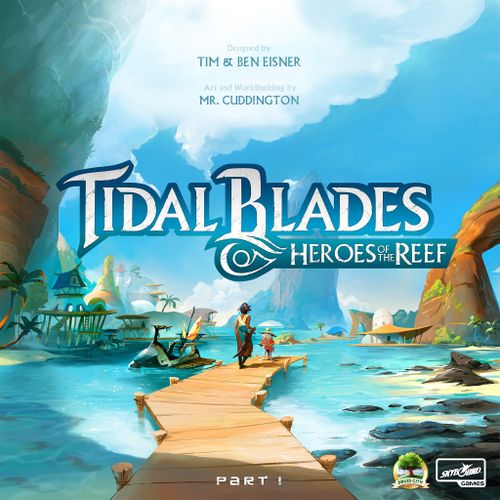
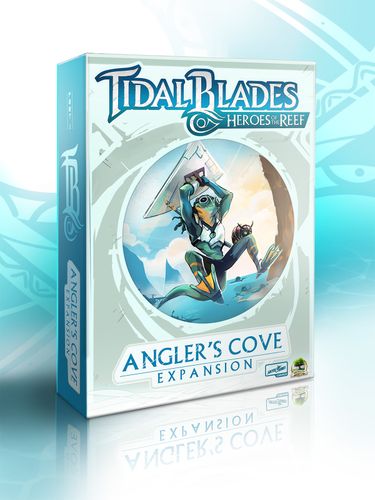
Gameplay Overview
This is a general overview to provide context for the review, not an in-depth how to play. Some rules are glossed over or missing and in this case we definitely don’t cover all the many variant options.
We’ll mostly focus on the base game first, since the Angler’s Cove Expansion builds off those rules.
Game Flow
Tidal Blades is played over 4 rounds (5 if playing the alternate side of the Citadel board). Throughout the game, players move their character and action tokens to various worker placement locations around the central boards. Each time they move, they leave behind a token so that previously used spaces will be blocked for the rest of the round.
Game Layout
As with most components in Tidal Blades, the board set up reinforces the setting and theme of the game.
The game board in Tidal Blades is made up of 5 distinct islands with worker placement spaces on each island with a “Champion” track above them all. Thematically, your character is visiting each island and completing tasks to improve their skills and standing (champion track) in the competition to become a Tidal Blade.
Each Island also has an island bonus associated with it:
- Chronoseum – draw a stunt card (these usually give you bonuses)
- Lamara Stadium – move the boat forward one space and gain benefit
- Droska Ring – purchase market card or gain 1 fruit (market cards give you items)
- Citadel of Time – choose or draw 2 challenge cards
- The Fold – fight a monster
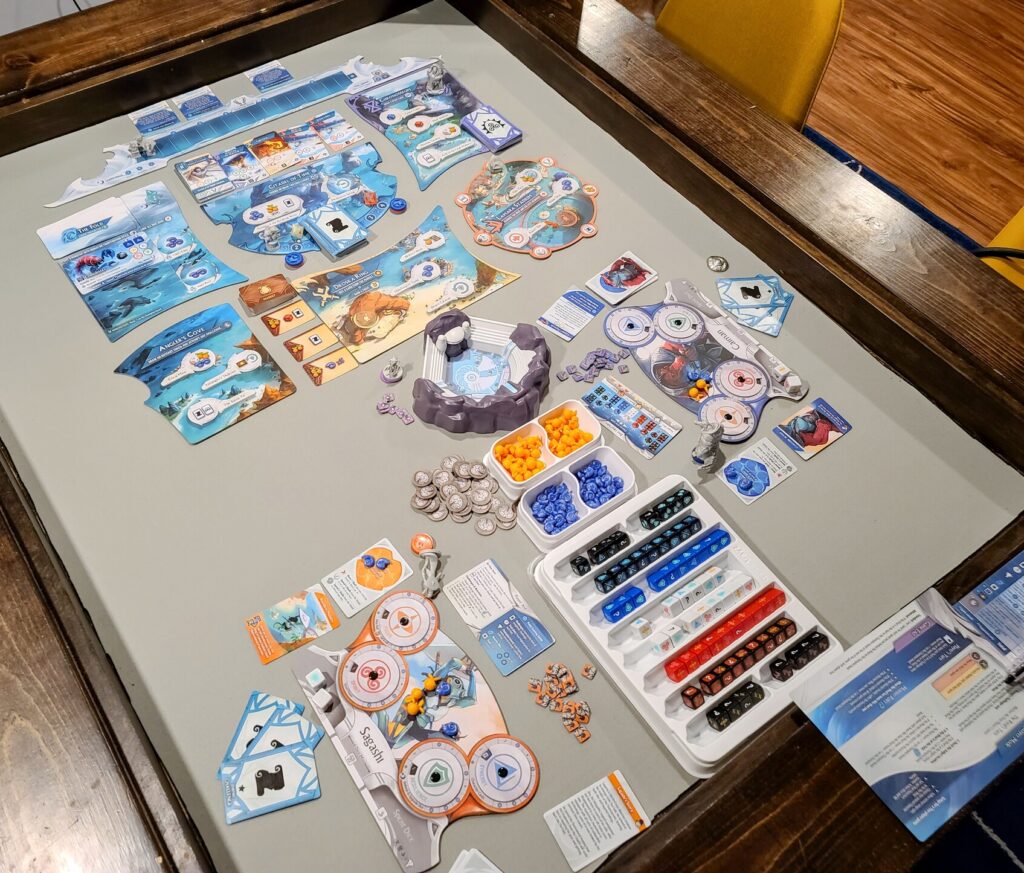
Turn Overview
A turn itself is very simple; the complexity comes in all the concepts we’ll lay out in a moment. Players take turns each round moving their characters and performing actions. In the first round, players have 2 actions depicted by action tokens they leave behind (and therefore block the space) as they move around. All players get a 3rd token in the second round, and a 4th token in the 4th round.
On your turn, you:
- Move character and action token to an open space
- Take the reward or complete the space action
- Take the island bonus
- Optional actions depending on the island:
- Complete a Challenge
- Fight a Monster
Next, we’ll go through a bunch of core concepts that tell you how to actually play the game and make decisions.
Concept: Traits
Traits are the character building / level up mechanism of the game. Increasing traits throughout the game gives you abilities that make you more effective each turn.
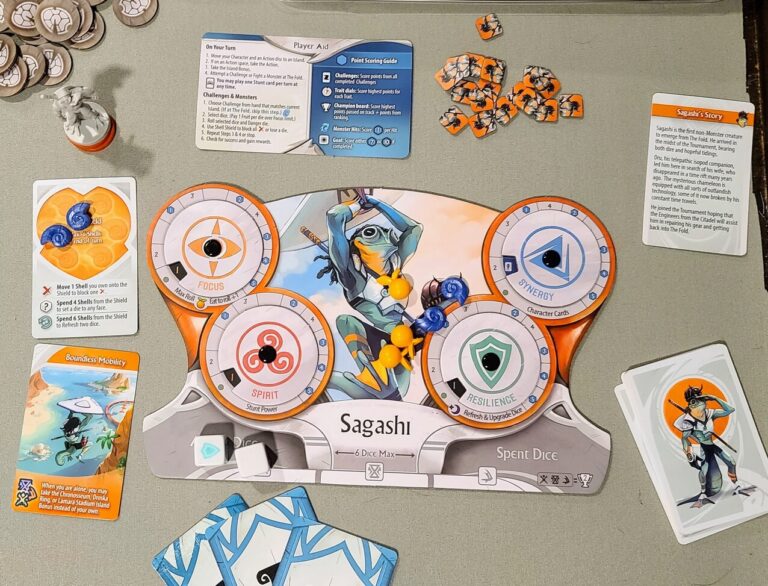
Here’s how it works: The player board has four dials that are adjusted up when you complete challenges or fight a monster (or sometimes get bonuses). Side note – sometimes dials like this in a game are super fiddly and annoying. These are high quality and actually function!
Traits:
- Focus: How many dice you can roll at once to complete challenges or fight monsters. You can also temporarily increase the number (don’t spin the dial) with 1 fruit per extra die.
- Spirit: Power up stunt cards. The higher the spirit trait, the more powerful the stunt card bonuses.
- Synergy: (aka that thing your office coworker can’t stop saying in EVERY meeting, Todd) You can have active character cards up to your synergy number. Character cards give you asymmetric bonuses – each character has a unique deck with unique abilities.
- Resilience: Upgrade and Refresh die at the end of each round to your resilience level (more on that below).
Pro Tip: You will never get to a high level on all four. Usually, we’d get pretty high on one or two of the four, then have lower values on the others. Emily prefers to go for Resilience right out off the bat because you only have 3 opportunities in a 4 round game to take advantage of it. Sarah usually goes for Synergy early on to get more sweet character card bonuses.
Concept: Dice Upgrade Path and Refreshing
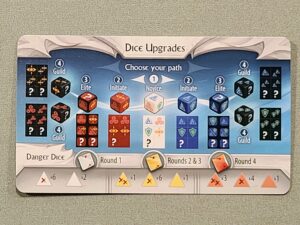
If you want to do anything, you need dice. More than that, you need the right dice and you need them available for use.
Your player mat has two dice sections: Active Dice and Spent Dice. All newly obtained dice go into the active dice area – these are available for use. Used dice go into the spent section and must be refreshed (moved back to the active section) before they can be used again. There are several ways to refresh die, but a big one is your resilience trait at the end of each round.
In our eyes, the key to a fun dice chucking game is having some control over the outcome. There will always be an element of luck, but you can take steps to increase the chances that it’ll work out in your favor. In Tidal Blades, a big part of this is the upgrade paths for the die. You can make choices to upgrade your dice to make it more likely to roll specific symbols.
Pro Tip: You can end up with a pool of dice that don’t have the right symbols at all! Make sure you plan ahead for what you need, or you might be relying completely on the rare “?” symbols.
Watch out! Each round has a special “danger die” that’s rolled alongside the dice you’re using. If you roll a “X” you need to spend a shell from your personal supply, or you lose one of the dice you’re trying to use. As the rounds progress, the danger dice have fewer blank faces and more “X” faces!
Concept: Challenges
So what is it, exactly, that you’re trying to accomplish? Almost everything you do during the game is aimed at two things: completing challenges and fighting monsters (more on monsters in a moment). How else would you prove your worth as a Tidal Blade?
You start the game with a hand of Challenge cards and gain more by drafting at the Citadel of Time. Each challenge card corresponds to either Lamara Stadium, Droska Ring, or Chronoseum and has a number of trait symbols (and cool artwork!).
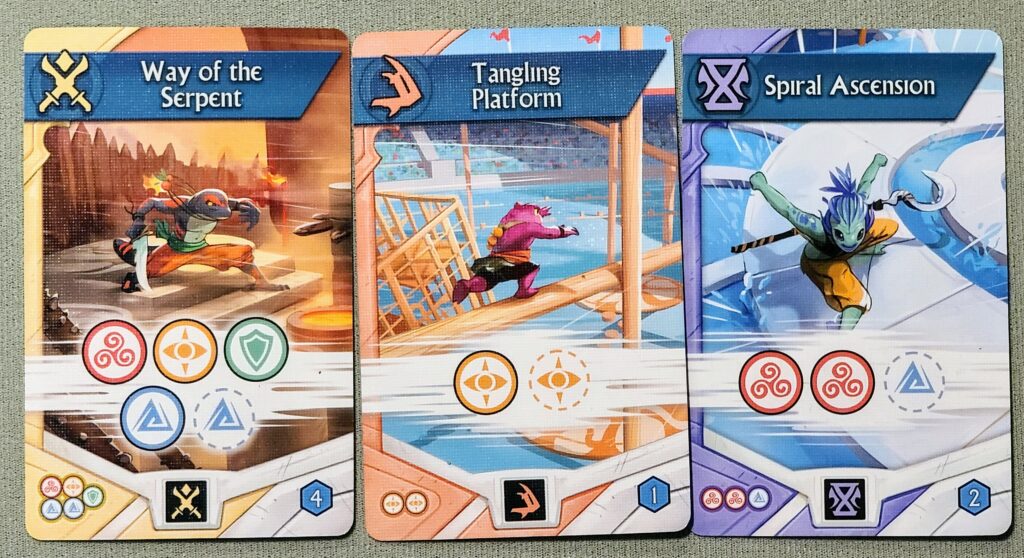
You can complete a challenge during your turn after you’ve moved to the correct island and complete the space and island bonuses. Then you roll a number of dice equal to your Focus level + optional paid fruit. If you roll all the trait symbols with a solid border (or use modifiers from various sources), you can complete the challenge. All challenge cards have at least one dotted line trait that’s a “push it” bonus, you can complete this as well only if you matched the solid line traits.
Move the matching trait dials on your player board up for each solid line symbol successfully rolled, and each dotted line symbol rolled (note that you MUST complete all solid line symbols to complete the challenge and to get the “push it” bonus).
When you complete a challenge, you slide it under your player board so the symbol is visible – you’ll need this for monsters. Then move your dice to the “spent” section. They need to be refreshed before they can be used again.
Pro Tip: You can also withdraw from a challenge if you don’t have shells to protect against the danger die, or realize that probability is not on your side. When you withdraw, you still advance the traits of the symbols your matched, not including push it symbols but you do not keep the card.
Concept: Monsters
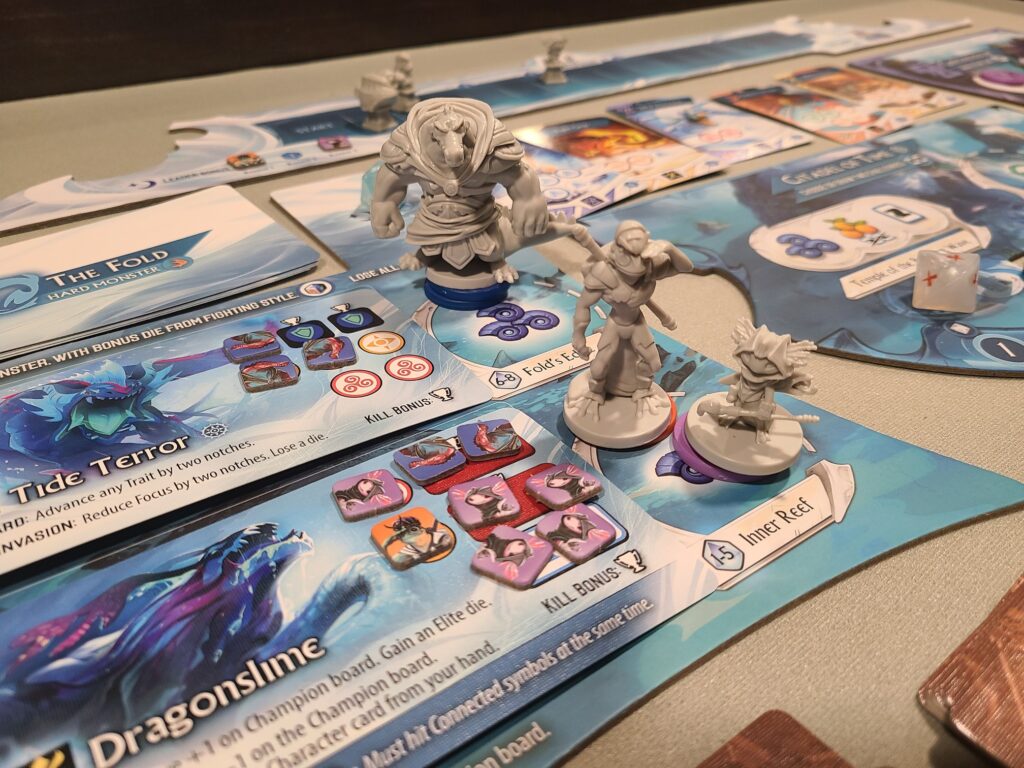
Oh no! Monsters have invaded the Fold! Once you earn enough skills doing challenges (that is, you have moved your trait dials around a bit), go face a mighty beast! These work very similarly to the Challenges. You must roll the matching trait symbol shown on the monster cards. You use your Focus + fruit to determine the number of dice from your “Active” area plus one bonus die if you have completed challenges with an island symbol matching the monster’s symbol.
Monsters have more restrictions and usually WAY more symbols than challenges, but you don’t have to kill the monster to get a benefit. For every matching symbol you roll, you block it with an adorable little character token and increase that trait dial on your player board.
Big Deal: Unlike challenges, dice you use fighting monsters go back to the general supply, not your “spent” area.
Pro Tip: Even if you aren’t going to be able to kill it, there are major benefits to having your player markers on the monster card. They’re end game points and even if someone else kills it, you still get the bonus. Also, if the monster invades or flees at round end, you don’t take the penalty.
But Wait! There's More...
- Shell shield: move shells on and off the shield to cancel out effects of the danger die, change the face of a die, or refresh die.
- Champion board: this gets you points at the end of each round and the end of the game based on your standing. You move up and down the Champion board based on completing challenges:
- Complete a challenge on the same island as the Judge: +1 Champion board
- Complete a set of all three island challenges: +2 Champion board
- You can also move up by fighting monsters or (rarely) bonuses and character cards
- Character goals: you have a secret goal you are trying to accomplish for additional points
Round End
Overwhelmed yet? Good, there’s more. At the end of each round there are a few tasks:
- Monsters:
- Invade! Roll the invasion dice and perform the invasion penalty for all players who don’t have a token on that monster (that is, for anyone who didn’t successfully fight it)
- Move monsters: move down one space. The lowest monster may flee, which means anyone who didn’t have a token on it gets -1 on the Champion track. Replace an empty space with the next monster from the deck.
- Retrieve action tokens & character
- Move the judge to the next island
- Take action tokens (rounds 2 and 4)
- Refresh & upgrade dice to Resilience level. This gets a tad tricky – if you refresh dice to your Resilience level, you can only upgrade the dice you refresh. BUT, you can choose not to refresh the full number of dice and then also upgrade from the “active” section. Think of it like you can only impact the number of dice equal to your resilience. For example, you have a Resilience level of 2. You can choose to refresh 2 dice and upgrade both of them, or you can refresh one die and then upgrade a die you have in your active area (for a total of 2).
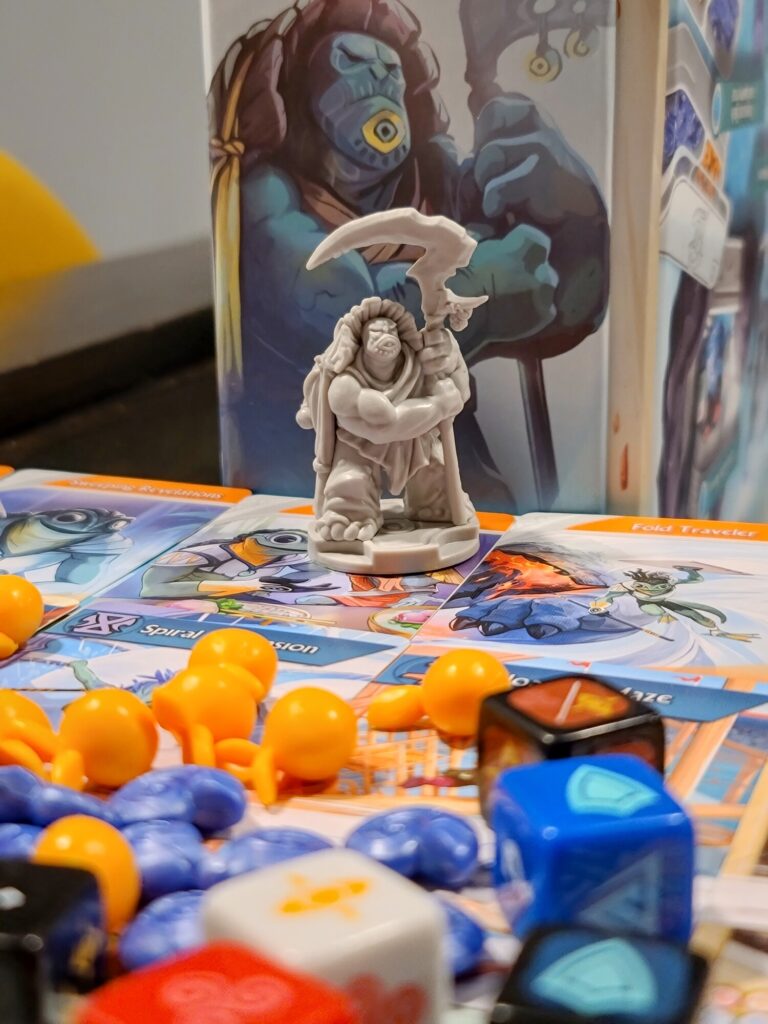
End of Game
You score in several ways: completed challenges, tokens from fighting monsters, and the Champion board are the three main ones. Variants (see below) may have additional ways to score.
Note: This game tends to be pretty low-scoring for how much is going on. A couple points ends up making or breaking your end score, so make good choices!
Variants
We aren’t going over all the variants, but here’s the gist:
- 2-Player: we (mostly Emily) LOVE the 2 player variant. You play with a “robot” character who travels around the islands, blocking your paths, making it tougher to fight monsters and overall wrecking your score.
- Solo Mode: We haven’t tried this yet, but there is a built-in solo mode in the base game.
- Longer game: flip the Citadel of Time over to have 5 rounds instead of 4. Again, we really like this since you feel like you accomplish more in a game
- Legendary Challenges: Mix-and-match challenge sets with different, but mostly self-explanatory rules
- Advanced Market Cards: similar to legendary challenges, mix-and-match sets with self-explanatory rules
- Advanced Monsters: Not in sets, but there are monsters that are more difficult and have special rules and restrictions. WARNING: the advanced monsters are no joke. We do not recommend using them until you are very comfortable with the gameplay.
- Public Announcements: Instead of secret character goals for extra points, there are three public goals. We found these lead to higher point scoring games.
Expansion: Angler's Cove

This is the last thing in gameplay, we promise!
The Angler’s Cove expansion makes this almost a new game. It adds a press-your-luck mechanism that increases the tension and shifty across-table eye contact tenfold.
It also adds a new character (time-travelling frogman and his telepathic trilobite sidekick, obviously). It also adds a new island with super powered action spaces, new challenges, new monsters (monster hunters, actually), new market cards, and a 5-player mode. With the exception of the new character, who can be played whenever, the Angler’s Cove expansion is not really meant to be mixed into the game. It adds new rules that work together with all the new card types and new island. Generally, you play with or without the Expansion.
The outcast tokens are what makes this fun. Each time you go to the new island (remember: amazing bonuses from the action spaces), you draw a face-down outcast token. These have numbers 1-4. The player with the highest total outcast token value at the end of the game gets -5 points. Tidal Blades is low scoring (~40-50ish is a good game for us at 2 player), so -5 points is a LOT.
What do we think?
OK – there’s a lot going on in Tidal Blades (seriously, that gameplay overview is nearly as long as some of our heavy Euro reviews), but when we’ve played it’s not as much as it sounds. Once you get familiar with the different boards and action spaces, the game is actually pretty approachable and does a good job of balancing some strategy without becoming overwhelming.
The big question with a game that gets this much attention – is it over-hyped? In this case, we’d say the hype is earned. We’re split a bit on the degree to which we like the game, but it’s so flexible with so many variant options that anyone can probably find their favorite ways to play.
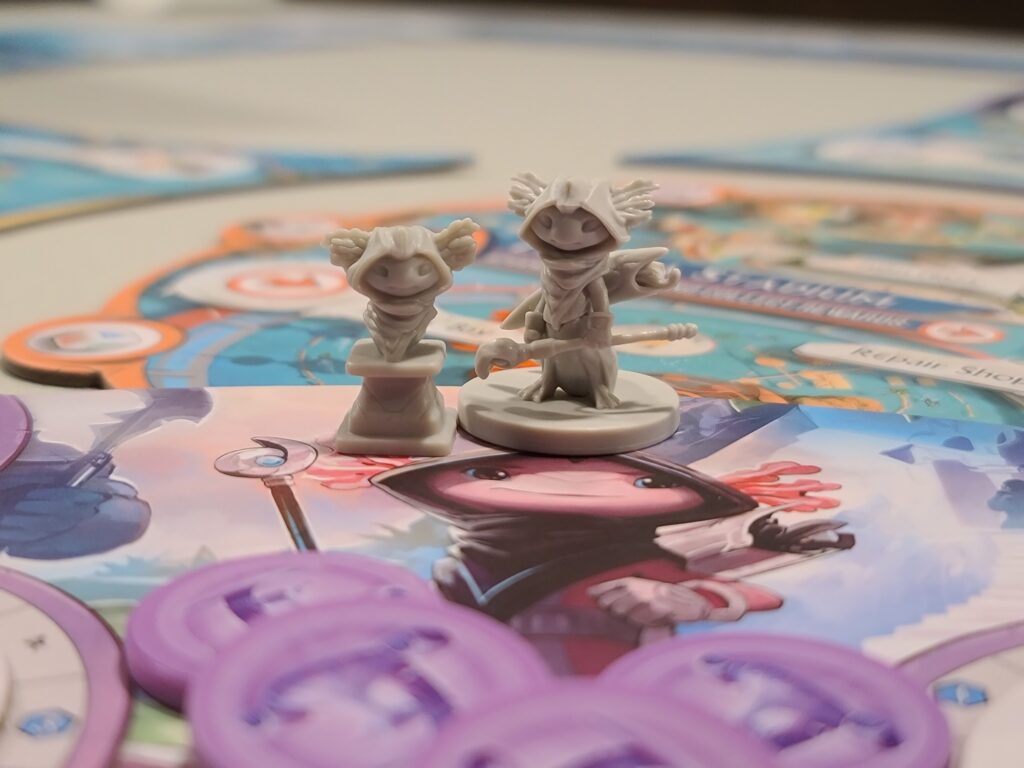
What did we like?
Tidal Blades clearly draws inspiration from mix-and-match games like Dominion, where certain elements can be added or excluded each game to change how it plays. This results in a game that feels customizable and, for us, trying out all the different options (like the legendary cards) is part of what keeps drawing us back to the table.
Don’t like the monsters as much? Maybe put more “easy” monsters into the deck. Want to make it harder? Throw some legendary cards in there. Want to try something different? Well, the characters have asymmetric powers – you should have a different approach for each character.
We obviously can’t talk about what we like without mentioning the incredible theme integration, amazing artwork, and quality pieces. Everyone involved in creating this game went HARD. Is it a bit overboard? Yes, definitely. And we love it. From the pieces to the dice tray to the box insert, everything about this game is extra in the best sense of the word. There’s even a worldbuilding and character backstory coffee table book that makes an excellent bedtime story for Rowan (he LOVES Caiman the muscle-bound crocodile dude. We told him he got strong eating fruit and now Rowan wants to feed the fruit resources to the mini).
For anyone with kids – Rowan also likes playing “on a team” because of the storytelling aspect. This means we actually get to play this during the day when he’s awake!
We really like two changes to the base game:
- 2-player variant: this is super hard! The stupid robot always goes right where you need to go and fighting monsters becomes way more important. But this variant tightens up the 2 player game and ramps up the tension.
- Angler’s Cove Expansion: this changes a lot about the game, adding in new cards but also a new key mechanism. It makes it a different game – you make different decisions and the “feel” is unique to the base game. We wouldn’t always play with the expansion, but it’s great to shake it up. The expansion rules only have you using 4 monsters total, we choose to add more. There’s probably a reason not to…oh well, we like fighting monsters!
What didn't we like?
Tidal Blades can be “fiddly”. You’re moving resources and small pieces and tokens all over the place throughout the game and it can be tedious at times.
We mention above that the legendary cards come in sets that can be mix-and-matched for each game. There are a few of the sets we didn’t like as much – the ones that made the game harder without really adding new elements. This game can already be very difficult because of the luck element so things that just add difficulty without a twist don’t add much fun. An example is the legendary challenges that just make it harder to complete the challenge for a few more points. We didn’t find this to enhance the game much.
There is also a lot of overhead on this game for the weight. All that flexibility in setup and gameplay means there are a lot of rules and options that might seem overwhelming and too complex at first. The rulebook actually does a good job addressing this by making “first game” setup suggestions that streamline some of these decisions. Once you get a few plays under your belt it’s much easier to see how everything fits together.
Who will like this game?
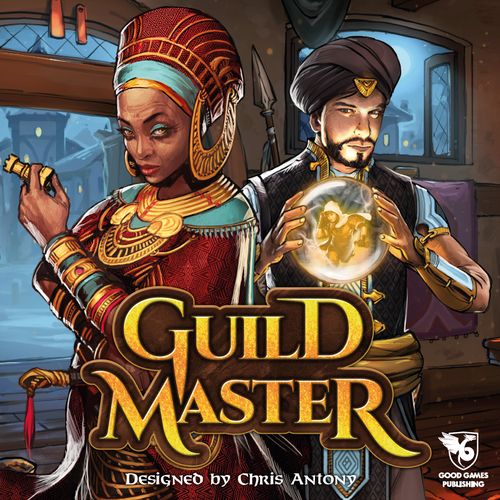
This is a great mid-weight game that we see appealing to wide audiences. It’s so flexible that it would be good for players who get bored quickly or who love trying new things. Some of the variants make the game feel completely new.
Even though it’s medium weight, this would probably be a bit hard for new gamers unless they have someone teach them and are patient. Actual game play is not that complex, but getting through the concepts might be overwhelming. Experienced gamers will recognize familiar concepts put together in new ways.
If you like games like Lords of Waterdeep, Guild Master, or Everdell this might be a good fit for you.
Sarah's Take
Tidal Blades is probably the nicest looking game we’ve played in a long time, if ever. The art, components, and immersive worldbuilding immediately drew me in. Is the game overproduced? I thought so at first. So much so that Emily and I discussed and agreed to talk about the production quality in our separate takes because we had pretty varying opinions on it. But the more we played and interacted with the game, the more I began to see that the production is almost its own mechanism of the game. It’s the path you follow on during your self-guided tour of the islands of the reef. It’s not necessary by any means, but it’s fun and pretty.
The gameplay in Tidal Blades isn’t fancy or innovative, but it’s consistent and fun. The character cards are without a doubt my favorite part of the game. I love bumping up my Synergy trait so I can get more character cards and new abilities. The abilities that can be unlocked are super fun and satisfying to synergize together in exciting ways.
Emily's Take
Sarah likes to joke that the best way to tell if I’m having fun with a new game is if I’m sitting in silence for two hours, scowling down at the table.
Tidal Blades is a different kind of fun (okay, she has a point, I usually am having a lot of fun if I’m stressed out). In Tidal Blades, there’s no need to get worked up over strategy, just do your best and have a good time. Instead of scowling the whole time, it lets me relax without being boring.
I liked the production level immediately. I’ve got a thing for good quality pieces and interesting, beautiful artwork in a game and this has that in spades. I also like the little details worked in – the character card decks have a “backstory” card that described the character and how their personality influences the card abilities.
I don’t often like games with a heavy luck element, so the fact that I like this game so much is a testament to how well it balances the luck with other great mechanisms like worker placement and card drafting.
Breakdown
Rulebook / Learning the game
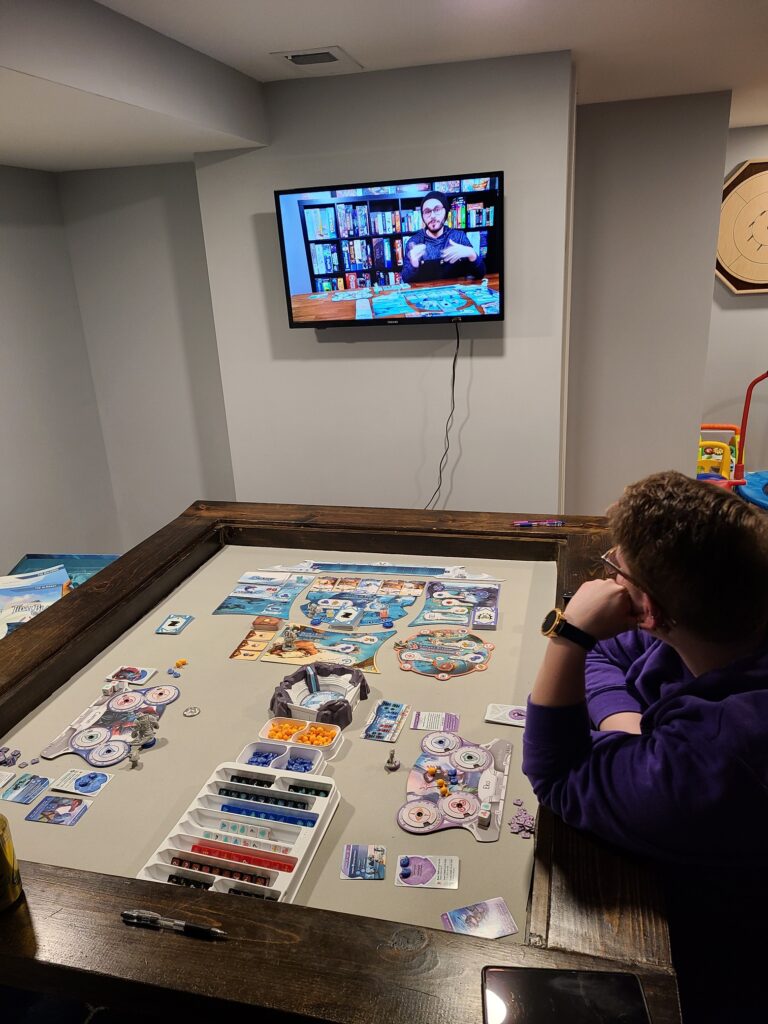
The rulebook is well laid out and easy to reference. We started off by watching a how to play video, but found that there are so many little details in the game that we still needed to walk through the rulebook for a full understanding of the game. We also ended up referencing the rulebook frequently during the first few plays.
One minor nuisance is that the two player variant is in a second “almanac” book. The rulebook is clear in stating this multiple times, but it is something else to keep track of and some of the things in the almanac would typically be in a normal rulebook, like a “quick reference” guide on the back. That said, if it was all in one it would be a novel.
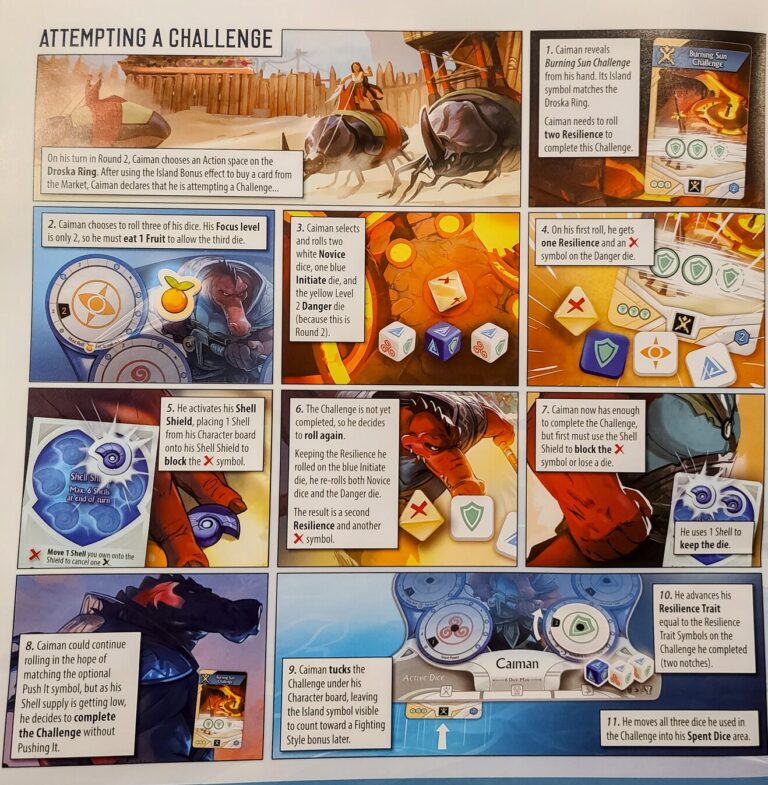
First Play
In our first play, Tidal Blades was pretty easy to mechanically wrap our heads around. It’s a standard worker placement game with elements of dice chucking and upgrades. About ¾ of the way through, the strategy clicked for both of us. We were tempted to immediately reset and play again.
Subsequent Plays
We played quite a bit of Tidal Blades over an extended period of time. The more we played the more we understood the characters and how the traits could synergize with the character decks and what we really needed to focus on to be successful. And there’s something to be said for how everything fits together perfectly that makes the otherwise overwhelming setup/takedown way less of a pain, which increases our likelihood to break it out again.
Parent Perspective
Interruptions
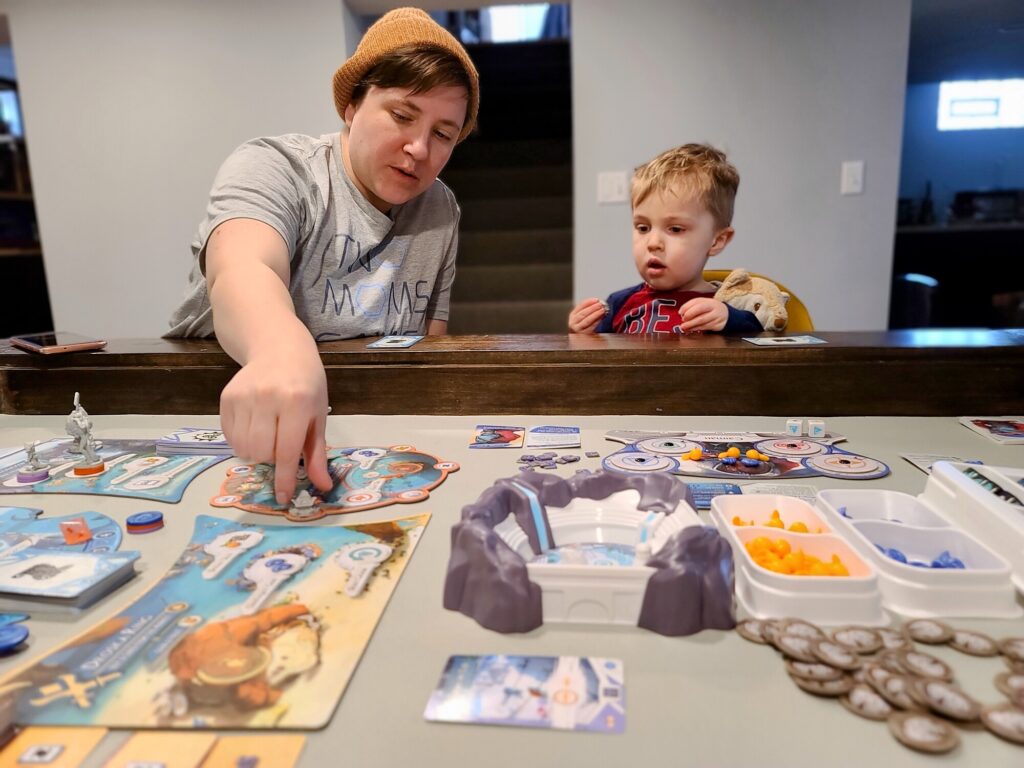
Throughout our plays of Tidal Blades we were interrupted about 18 bazillion times. The bad news is that it took us forever to play some games for how many times we had to pause. The good news is that Tidal Blades handles interruptions as well as any worker placement game. There is essentially no player interaction (aside from blocking a space) so if someone needs to step away from the table they can safely do so immediately after their turn.
Because your strategy is dependent on what spaces are available you always have to maintain some flexibility making it easier to mitigate unexpected pauses from derailing your whole gameplan.
The round end upkeep includes handing out monster invasion effects, but that is something simple enough that we had no problem with one of us assessing the monster attack and doing the end of round upkeep as needed while the other went to get Rowan some bedtime milk.
Time Investment
Without interruptions a two player game of Tidal Blades takes us about an hour to play, maybe less if we’re focused. There are a LOT of pieces and variant decisions to make, so give yourself an additional 15-20 min for setup and 10-15 for cleanup.
We did not get a chance to play Tidal Blades with a higher player count, but we would anticipate it adding about 15-20 minutes per person to the overall time.
Life Fit
Tidal Blades is a quick playing game that can be played on a weeknight with relative ease. It’s also not so heavy that you’re too tired after a long day. Like we mentioned, set up and clean up can be a chore, so we typically have one of us start setting up while the other wraps up dinner or bedtime with the boys. Or we do the SUPER lazy thing where we set it up, decide it’s actually too late, then keep it set up on the table for 3 days until we have another chance to play. That’s not unique to Tidal Blades, though.
Rating
7.5/10
We’re split – Emily is an 8 (maybe 9), Sarah is a 7. We score based on how often we’d bring a game to the table, so this high score reflects how much we like it despite the pretty intense setup/takedown required. This is the perfect game for a bottle of wine and good company.
*See our rating scale HERE
Click through for more posts, or follow us on social media to see what we’re playing and for new post updates!
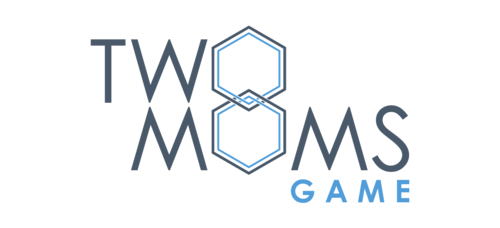
Just now discovering your site, while looking for more info on this particular game. Talk about production values! Tidal Blades has nuthin’ on you! Thank you for this amazingly thorough and thoughtful analysis… and the interruptions metric! +1 +1 +1 what a great concept! Guess I have another content provider to follow. 😉
Thanks Drew!